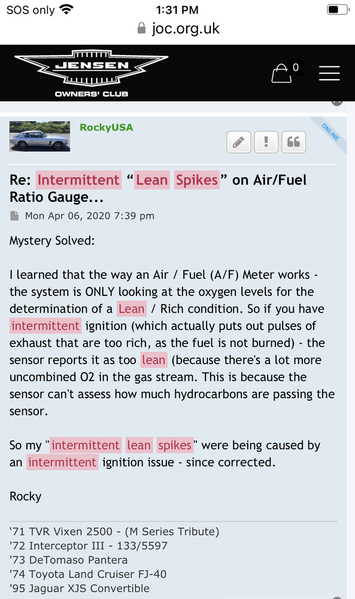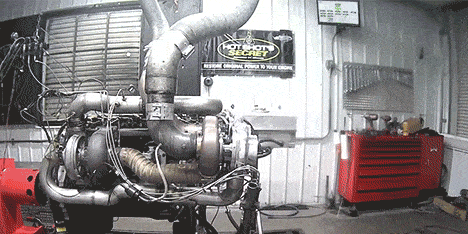I have read through what I can find in the forums and have tried most options presented.
First, the info:
This is a PIM 427 Hammer engine in a friends Pantera. Please recall this is a 351Windsor, bored and stroked to 427. Cam specs are not known (I've not heard back from Jerry yet). I have had it in my shop for a short list of other items and was asked to take it for a long drive to assess engine performance. Well, it didn't take long to figure out it feels like a lean surge at cruise on level ground. However, under load, uphill, or getting on it, it pulls fine and feels good and smooth. Deceleration never burbles (which bothers me) and never backfires.
I am using an AEM 30-0300 AF gauge to monitor the lean/rich condition at the exit of the exhaust tops. It does -not- have an O2 bung for a sensor so I'm using an Innovate Motorsports O2 clampe.
At idle, with about 18* of initial timing, (38* at 3,000 rpm) and leaning the mixture screws to about 1/2 out from full-in, I get a vacuum reading of about 10, smoothest idle, and AF north of 24 (often pegging the meter at full lean). But if I richen the mixture to try and get AF at least into the teens, I lose vacuum down to about 5 and start to get stumbling.
Separately, while driving under load, uphill at moderate throttle, I can get a vacuum of 13 and an AF of between 12 and 13. The moderate load mixture appears to be about where I want it, but cruise and idle show north of 24. This is too lean.
I've had the Demon carb off and on. It originally had:
Primary jets: 82
Secondary Jets: 93
Power Valve: 4.5
The Primary jets were changed to 86 (what I found it was supposed to come stock with?), and I upped the power valve to a 5.0. All else remained as stock. Throttle plate opening is per Demon spec at 0.020 exposed transition port open on both primaries and secondaries.
This did not help cure the lean surge at cruise. And I still can't adjust idle for anything under 20. Again, if I start to richen the idle mixture, I start losing vacuum and eventually can get the car to start stumbling way before I get into the high teens for AF ratio.
I am stumped and losing my mind. I've used propane to check for vacuum leaks around the base of the carb and the intake runners. I have not found any, therefore I'm beginning to suspect a vacuum leak under the intake. Unless this behavior is normal for this engine.
Please check my thinking on this.
If I continue to increase the primary jet size, it should cure the lean surge since the throttles are supposed to be off idle and using the main jets. But what about the idle? Since that is a separate circuit, it should not be using the main jets, but I can't get the AF into a non-lean range with the mixture screws.
The engine does not ping, it does not backfire through the carb, it does not backfire through the exhaust.
I'm working to install a different carb for troubleshooting, though I expect it will probably act the same.
Why would I not be able to get the idle mixture into the teens?
Should I continue going richer on the primary jets?
Once I have the primary jets so I don't lean surge at cruise, how much bigger should I make the secondary jets?
Or does it sound like I've got a vacuum leak and I need to take the intake off?
Thank you,
Asa Jay





